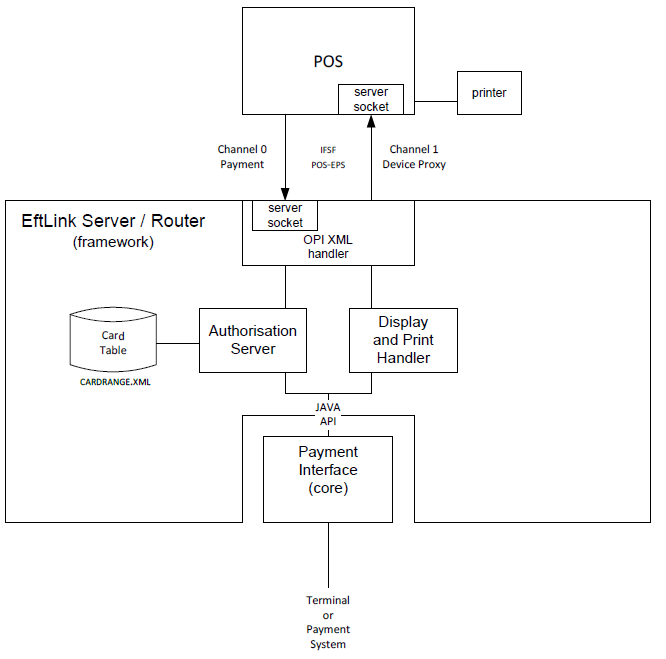1 Overview
Installation Guide Overview
Installation of EFTLink consists of the following steps:
-
Extract the EFTLink files from a zip -
eftlink_v22.0 zipto a folder on your system. -
Select one specific core to connect to the EFT system or terminal to be used. Separate batch and script files are provided to do this for each core from a command line for both Windows and Linux.
-
Install EFTLink as a service – a batch file is provided for Windows. For Linux either the EFTLink application can be called at start up or set up as a daemon.
-
Configure the specific core.
The Oracle Retail EFTLink Framework Installation Guide covers the installation and configuration of the framework for EFTLink. A companion volume, the Oracle Retail EFTLink Core Configuration Guide, details the specific settings required to configure each Core to communicate with a specific payment system.
Product Overview
There are multiple manufacturers of Point of Sale (POS) terminals on the market. There are also large numbers of manufacturers of card readers and PIN Entry Devices (PEDs). These card readers can accept a wide variety of cards including debit cards, credit cards, loyalty cards and fuel cards for motor vehicles. These cards are provided by a wide range of issuing organizations each with their own Electronic Payment Systems (EPS). Interconnecting the POS systems, card readers and EPSs is a complex task.
EFTLink is an efficient, platform independent way of providing the connection. It is written in Java, distributed as a Java library and readily added to the software of individual POS terminals.
EFTLink is a router and protocol converter that presents a standard interface to a payment client (typically for a POS) and links to any card readers or authorization systems in use at the retailer. The interface with the authorization system is therefore separate from the POS, removing any impact of country-specific or server-specific requirements from the POS itself.
EFTLink comes in two parts:
-
The EFTLink Framework
-
EFTLink Cores
The EFTLink Framework provides a system-independent execution environment (a framework) for a targeted EFT solution. The EFTLink Core for a specific terminal or payment system is implemented as a plug-in module that runs within that framework.
Oracle can provide cores for many of the most used card readers or PEDs. Cores can also readily be written for any other card readers or PEDs that require them. Once a core is available for a specific device it will normally work on a range of POSs without further modification.
The POS/EFTLink interface conforms to the Open Payment Initiative (OPI). This is an open standard, widely used in the retail industry. Over time, the original OPI specification has been adopted, extended and maintained by the International Forecourt Standards Forum (IFSF). This enhanced IFSF POS-EPS version is now taken as the definitive specification.
EFTLink is not a full implementation of the IFSF POS-EPS specification. Instead, it uses those parts of the base specification that are pertinent to the sales of dry goods in the retail sector and to the sale of wet goods in petrol (gas) stations. EFTLink includes all the main messages from the IFSF POS-EPS specification and those messages contain all mandatory elements and attributes. EFTLink also includes optional elements and attributes that are commonly used by retailers.
EFTLink can also be extended beyond the IFSF POS-EPS specification. This allows additional features to be included to deal with extended payment or loyalty requirements being driven by new initiatives in retail. This gives considerable flexibility in dealing with the evolving requirements of the future.
Examples of where EFTLink is used include:
-
Payment, Refund, Reversal, Pre-authorization and Completion.
-
Loyalty Award and Redemption, Balance inquiry, Discount voucher/coupon, IOUs.
-
Stored Value Cards – Load, Redeem, Balance inquiry, Activate and so on.
-
Online Agents – E-top-up and utilities payments.
-
Tokenization, Gratuity, Cashback, DCC, Ad-hoc card read.
-
Combined Payment and POS receipts.
-
Maintenance functions.
-
EPS/PED pooling.
Architectural Overview
EFTLink is a router and protocol converter, presenting an IFSF/OPI interface to a payment client (typically a POS), and linking to whatever authorization system (or systems) the customer uses. The adoption of a standard IFSF/OPI interface makes EFTLink portable to other POS or payment environments. EFTLink is not in itself a complete solution. What it provides is a system-independent execution environment (a framework) for a targeted EFT solution. The core implementation for a specific terminal or payment system is implemented as a plug-in module that runs within that framework.
Figure 1-1 Oracle EFTLink OPI Server/Router

Miscellaneous Data Disclaimer
EFTLink along with some selected Cores, has the ability for additional
data to be sent and received in a field called <MiscellaneousData>.
This can be used by System Implementers (SIs) and Payment Service Providers (PSPs) to pass additional data in the messages between Xstore and the Payment Providers, using custom code.
Typically, this is used to add directives which we can trigger different payment workflows. However, it can also be used to capture additional payment data for downstream processing for the Retailer's to use for reconciliation or financial purposes.
Under no circumstances should any PCI or potentially sensitive PII data be placed in this field. Oracle will not be responsible for any issues caused by integration changes made by SIs, Retailers and Payment Providers, that enable sensitive data to be added into this field.